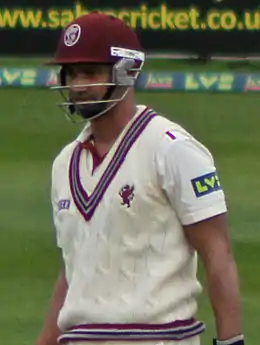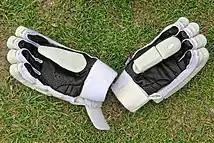Cricket clothing and equipment
Cricket clothing and equipment is regulated by the laws of cricket. Cricket clothing, known as cricket whites, or flannels, is slightly loose fitting so as not to restrict players' movements. Use of protective equipment, such as cricket helmets, gloves and pads, is also regulated.

Clothing and protective gear
- Collared shirt (usually white) with short or long sleeves depending on the climate or personal preference.
- Long trousers (usually white).
- Jumper (a woollen pullover, if necessary). This is usually a vest.
- Sun hat, cricket cap or baseball cap.
- Spiked shoes to increase traction.
- Protective equipment
- Jockstrap with cup pocket into which a "box", or protective cup, is inserted and held in place.
- Abdominal guard or "box" or an L Guard for male batsmen and wicket-keepers (often referred to as a cup, box or abdo guard). It is usually constructed from high density plastic with a padded edge, shaped like a hollow half-pear, and inserted into the jockstrap with cup pocket underwear of the batsmen and wicket-keeper. This is used to protect the crotch area against impact from the ball.
- Helmet (often with a visor), worn by batsmen and fielders close to the batsman on strike to protect their heads.
- Leg pads, worn by the two batsmen and the wicket-keeper, used to protect the shin bone against impact from the ball. The wicket-keeping pads are slightly different from the batsmen's. Fielders that are fielding in close to the batsmen may wear shin guards under their trousers.
- Thigh guard, arm guards, chest guard, and elbow guards to protect the body of the batsmen. Some batsmen use these and others do not, since they reduce mobility.
- Gloves for batsmen only, thickly padded above the fingers and on the thumb of the hand, to protect against impact from the ball.
- Wicket-keeper's gloves for the wicket-keeper. Usually includes webbing between the thumb and index fingers.
Batsmen are allowed to wear gloves while batting. The batsman can be also caught out if the ball touches the glove instead of the bat, provided the hand is in contact with the bat. This is because the glove is considered to be the extension of the bat. The batsman may also wear protective helmets, usually with a visor, to protect themselves. Helmets are usually employed when facing fast bowlers. While playing spinners, it might not be employed (though injuries are still possible[1]).
Fielders cannot use gloves to field the ball. If they wilfully use any part of their clothing to field the ball they may be penalised 5 penalty runs to the opposition. If the fielders are fielding close to the batsman, they are allowed to use helmets and leg guards worn under their clothing.[2]
As the wicket-keeper is positioned directly behind the batsman, and therefore has the ball bowled directly at him, he is the only fielder allowed to wear gloves and (external) leg guards.[3]
Cricket clothing is generally white In Test cricket, as is traditional, but limited-overs cricket players generally have clothing based on team colors, similar to other sports.
Equipment
- Ball – A red, white or pink ball with a cork base, wrapped in twine covered with leather. The ball should have a circumference of 9.1 in (23 centimetres) unless it is a children's size.
- Bat – A wooden bat is used. The wood used is from the Kashmir or English willow tree. The bat cannot be more than 38 inches (96.5 cm) long and 4.25 inches (10.8 cm) wide. Aluminum bats are not allowed. The bat has a long handle and one side has a smooth face.
- Stumps – three upright wooden poles that, together with the bails, form the wicket.
- Bails – two crosspieces made of wood, placed on top of the stumps.
- Sight screen – A screen placed at the boundary known as the sight screen. This is aligned exactly parallel to the width of the pitch and behind both pairs of wickets.
- Boundary – A rope demarcating the perimeter of the field known as the boundary.
See also
- Street cricket, where much of the equipment isn't used or is replaced with easier-to-find alternatives
References
| Wikimedia Commons has media related to Cricket equipment. |
- "India's Taniya Bhatia suffers concussion during Women's T20 World Cup final". The New Indian Express. Retrieved 31 August 2020.
- Appendix D Archived 3 December 2013 at the Wayback Machine Laws of Cricket. Retrieved 23 November 2013.
- Law 40 (The wicket-keeper) Archived 7 August 2015 at the Wayback Machine Laws of Cricket. Retrieved 23 November 2013.


.jpg.webp)

.jpg.webp)
